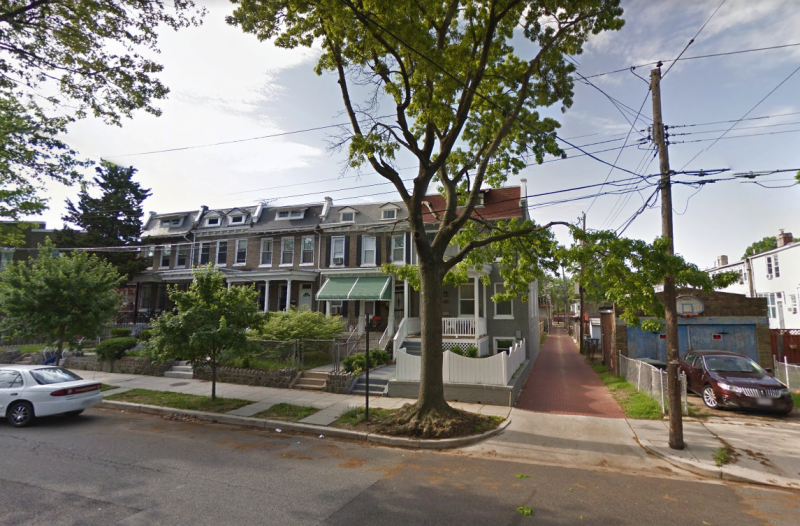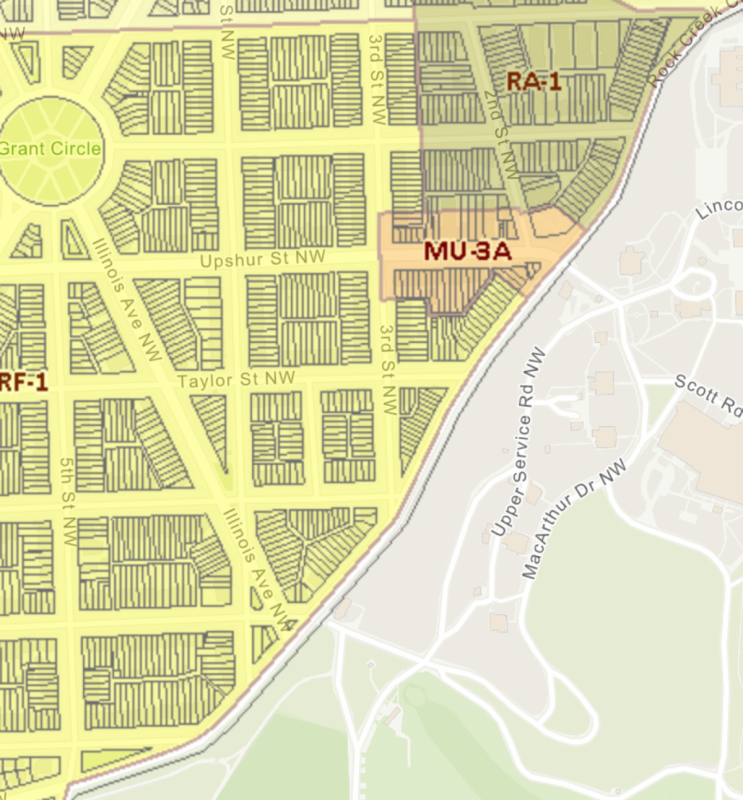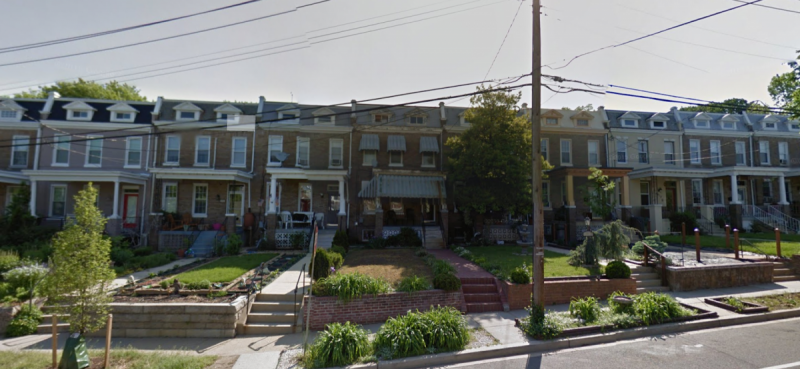How could your DC neighborhood fit 121 more homes?

Where could we fit more homes in Petworth? Image created with Google Maps.
In her recent inaugural address, DC Mayor Muriel Bowser called for more housing and revisiting the zoning code to handle the city's estimated population growth. Specifically, DC needs to produce 36,000 more homes by 2025. For people like me who represent communities where the market demands are already high, this is both a challenge and opportunity.
To get an idea of what 36,000 new homes would actually look like, we could, for the sake of this article, distribute them equally among each of the 296 ANC Single Member Districts (SMD). While an equal distribution is not ideal for many reasons, it gives us a number we can better conceptualize. That would mean 121 new units of housing added per SMD. (I’ll leave how to fairly and equitably distribute new housing for another post, but I see you Ward 3 with your big yards.)
My SMD in the Grant Circle area of Petworth is largely comprised of row homes in the RF-1 zone, with a very little bit of R-A-1 higher density blocks, which have mid-sized apartment buildings. I also have one block of mixed use MU-3A commercial and residential zoning.
ANC 4C10 with the Armed Forces Retirement Home campus to the east. 
There is little open space for new construction, so any growth here has to be a renovation of an existing row home.
Before I outline how my neighborhood would have to think about 121 new units of housing, let me be clear that our biggest need is large amounts of affordable housing. We need affordable family-sized units for new families to be able to move into our neighborhood, enroll in our local schools, and put down roots. We also need affordable senior housing to provide opportunities for our neighbors to age in the community they have called home for many years.
In the RF-1 zone, Inclusionary Zoning—which requires that 8-12% of a new development's square footage be made affordable—starts at the fourth unit and includes every even-numbered unit after that, so long as there are 900 square feet of lot per unit. In my neighborhood this means that almost no lot is large enough to build more than three market-price units. There is also no minimum requirement for affordable housing in my SMD.
With those constraints in mind, here is how housing production could happen in our community based on the current zoning laws.
Row home to three-unit conversions
We would need to convert 60 single-family homes into three units to get to 120 new units. If we only build row homes, each block would on average have four houses converted to three-unit condos or apartments.
This spreads the density out somewhat evenly, and spreads the burden of parking, population, and infrastructure needs.
Eight-unit pop-ups
Alternatively, if we look at the few blocks that have higher density with a focus on the Upshur commercial corridor, we could build some four- to eight-unit buildings instead. This would mean taking 100-year-old row homes in the R-A-1 zone and popping up and back, which would significantly alter their look.
We would need to convert about 20 lots into four- to eight-unit buildings to create 120 new housing units in this area.
219 Upshur (brick, 18 units) and 215 Upshur (red, 6 units) with single retail units to the east. Image created with Google Maps. 
There are other options if we amend the zoning
The above possibilities are all by-right, meaning they're legally-permissible right now in these zones. Developers are certainly already buying up row homes from elderly residents wanting to downsize. To reiterate: these are not ideal scenarios, nor ones that I am pushing for.
However, we do have a severe housing shortage and I think it's important that every neighborhood has a conversation about how it can contribute to addressing it. If not, we will continue to displace long-term residents, and lower-income neighborhoods will continue to disproportionately shoulder the challenges of rapid development.
Here in Petworth, this is how I think we start a dialogue about what we need and how we can consider welcoming our future neighbors.
- We build dense and tall at the metro station and on major transit corridors. ANC 4C advocated for express bus service and we can use that to rapidly get more people to the metro from new housing further out. This also means fixing the PUD system to allow density and community benefits to co-exist again in these areas.
- We must remove zoning language that “protects from density” surrounding areas like Crestwood along 16th Street, which pushes the challenges of navigating growth onto neighboring communities.
- We must change zoning laws to lower mandatory affordability thresholds in areas like RF-1 zones so that affordable units are a significant amount of the units built. Here are two draft amendments that would do that.
- We have to ensure that we are protecting residents from displacement.
- The community needs to create a plan and priorities that accepts that new housing needs to be built and articulates the community benefits we want. The current by right process is not conducive to the community shaping our growth. I have some ideas of how we trade density for affordable housing and beneficial use of retail space. However we need to have large scale community engagement.
- Build housing on any District-owned vacant land, like the Hebrew Home that ANC 4C supported, as well as other sites throughout the city like RFK Stadium.
The need for more housing is something we can't deny. Without any dialogue and plans though, we leave it up to developers and other forces to shape our community. How would you add more housing to your neighborhood?

